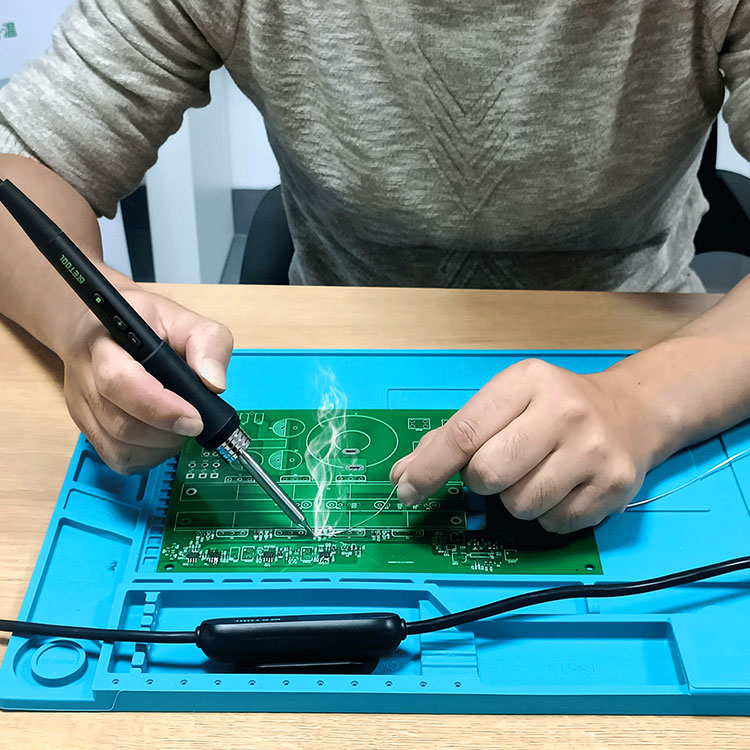After soldering, there are a few things that you should not do to avoid damaging the soldered joint and to ensure the success of your soldering project. Here are a few things that you should not do after soldering:
1. Do not disturb the soldered joint: After soldering, it is important to allow the soldered joint to cool and solidify completely before handling or moving it. Disturbing the soldered joint while it is still hot can result in damage, such as warping, cracking, or breaking, and it can compromise the strength and durability of the joint.
2. Do not apply pressure or force to the soldered joint: After soldering, it is important to avoid applying pressure or force to the soldered joint until it has cooled and solidified completely. Applying pressure or force to a hot soldered joint can result in damage, such as deformation or failure, and it can weaken the joint.
3. Do not expose the soldered joint to moisture or water: After soldering, it is important to avoid exposing the soldered joint to moisture or water until it has cooled and solidified completely. Exposure to moisture or water can cause the soldered joint to corrode or oxidize, weakening the joint and reducing its strength and durability.
4. Do not use the soldered joint immediately: After soldering, it is important to allow the soldered joint to cool and solidify completely before using it. Using a hot soldered joint can result in damage, such as deformation or failure, and it can compromise the strength and durability of the joint.
5. Do not clean the soldered joint until it has cooled: After soldering, it is important to avoid cleaning the soldered joint until it has cooled and solidified completely. Cleaning a hot soldered joint can cause damage, such as deformation or failure, and it can weaken the joint.
After soldering, there are a few things that you should not do to avoid damaging the soldered joint and to ensure the success of your soldering project. These include: not disturbing the soldered joint, not applying pressure or force to the joint, not exposing the joint to moisture or water, not using the joint immediately, and not cleaning the joint until it has cooled. By following these guidelines, you can ensure that your soldered joint is strong and durable, and you can avoid damaging the joint.

In addition to the things you should not do after soldering, there are also a few things you should do to ensure the success of your soldering project. Here are a few things that you should do after soldering:
1. Allow the soldered joint to cool and solidify completely: After soldering, it is important to allow the soldered joint to cool and solidify completely before handling or moving it. This will ensure that the soldered joint is strong and durable, preventing damage to the joint.
2. Inspect the soldered joint for defects or flaws: After soldering, it is important to inspect the soldered joint for defects or flaws, such as cracks, gaps, or voids. These defects can weaken the soldered joint and reduce its strength and durability. If you notice any defects or flaws in the soldered joint, you should repair or rework the joint to correct the problem.
3. Clean the soldered joint: After soldering, it is important to clean the soldered joint to remove any flux residue, oxide, or dirt that may be present. Flux residue, oxide, and dirt can weaken the soldered joint and reduce its strength and durability. To clean the soldered joint, you can use a solvent, such as alcohol or acetone, and a soft cloth or brush.
4. Protect the soldered joint: After soldering, it is important to protect the soldered joint from damage, such as corrosion, oxidation, or mechanical stress. To protect the soldered joint, you can apply a protective coating, such as a lacquer or varnish, or cover the joint with protective tape or a sleeve.
In conclusion, after soldering, there are a few things that you should do to ensure the success of your soldering project. These include: allowing the soldered joint to cool and solidify completely, inspecting the soldered joint for defects or flaws, cleaning the soldered joint, and protecting the soldered joint from damage. By following these guidelines, you can ensure that your soldered joint is strong and durable, and you can avoid damaging the joint.
Contact: Mr. Li
Phone: (0086) 138 24254 321
E-mail: atetool@atetool.com.cn
Add: 5F, 1-2# Building, Tongfuyu Industrial Zone, Aiqun Rd, Shiyan Subdistrict, Bao'an, Shenzhen, 518108, China